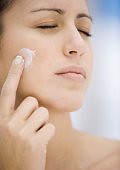
How Do I Combine Skin Care Products from Different Lines?
There are number of things to consider regarding timing when applying skin care products:
1. Using an anti-aging cleanser? Rub it onto your skin for a full minute.
According to renowned dermatologist Dr. David Bank, M.D., using anti-aging cleansers for less time doesn’t let the beneficial ingredients bind to the skin at their full capacity. These ingredients include (but are not limited to) glycolic acid, salicyclic acid, retinoids, colloidal oatmeal, soy, brightening agents like kojic acid or arbutin, and just about all antioxidants (vitamin C, vitamin E, coffee berry, idebenone).
2. Using all products from the same line? Apply them one after the other without waiting.
As I’ve mentioned before, there are detriments to using products entirely from the same line. For one, there are very few skin care lines that contain the majority of the potent anti-agers out there, including retinoids or alpha hydroxy acids, niacinamide/niacin/nicotinic acid, potent antioxidants, peptides and sunscreens with a high SPF. What’s more, there are virtually none that contain a high concentration of these ingredients and address separate concerns, like skin dullness or acne. Even worse, some companies are tricky and put far less of the active ingredient in the cleanser and toner than are worth the money, knowing that you will obtain the full benefit form the moisturizer and/or serum. These reasons explain why most of the dermatologists I have interviewed choose to use an assortment of products from different lines.
However, there are a few benefits to using products from the same line, including timing. If you are using all products from the same line, they are designed to synergistically work together. Not only are you ensuring that the ingredients will not negate one another with incompatible pH levels and eradicating the difficulty for active ingredients in lighter formulas to penetrate through heavier formulas, you are also guaranteeing that ingredients like propylene glycol, essential oils, and liposomal delivery systems (all of which enhance ingredient absorption into the skin) are working optimally. You do not need to worry about waiting between applications when you are using products from the same skin care line.
3. If you are mixing products from different lines, don’t mix acids with retinoids, or resorcinol with hydroquinone!
In general, for maximum efficacy, acidic products should be used together, and likewise with basic products. For instance, consider vitamin C and retinoids: It has been reported in the Journal of Dermatological Surgery that vitamin C and its derivatives should be formulated at a pH under 3.5 in order to allow the vitamin C to enter the skin. (For you science buffs out there, at this pH level, L-ascorbic acid is protonated and thus can penetrate the skin). Unfortunately, the pH optimal for retinol esterification, as mentioned before from the Journal of Investigative Dermatology, is between 5.5-6.0.
Some companies report that their ingredients are micronized or encapsulated, which makes for slower delivery over a longer period of time. While this slowed delivery process certainly might make the mixing of acidic and basic ingredients tolerable, I cannot find any blinded, controlled, randomized, peer-reviewed research establishing to what extent. So, for now, do not mix the ingredients in listed below with retinoids:
- Vitamin C
- Glycolic acid
- Lactic acid
- Salicyclic acid
- Nicotinic acid
Resorcinol has also been shown to cause ochronosis – a rare permanent darkening of the skin – in patients with darker skin types when used in conjunction with hydroquinone (Journal of Dermatological Treatment, 1997; American Journal of Clinical Dermatology, 2001). The effect typically appears after six months continual resorcinol use, with the highest reported incidence in South African Blacks. The mechanism involves effects on tyrosinase or alternatively by inhibiting homogentistic acid oxidase, resulting in local deposition of pigment (Dermatology Online Journal, 2008). Ochronosis is extremely rare in patients who do not have dark skin. However, I absolutely would not recommend that anyone mix resorcinol and hydroquinone!
4. If you are using products from different lines, apply the lightest formula first, followed by the heaviest. Sunscreen should always be last.
There are many agents known as “occlusive agents,” including petrolatum, mineral oil, and lanolin. These agents seal water (and other ingredients) into the skin, making them lovely components of moisturizers used in the dry and cold winter months. Unfortunately, they create such a barrier that it can be difficult for other skin care creams to reach the skin afterwards.
You should be able to feel which cream or moisturizer is the heaviest. However, there are documented “strengths” of the occlusive agents, as can be found in the textbook Aesthetic Medicine: Art and Techniques. if you are confused, in general, use the “lighter” formulas before the “heavier”, keeping in mind that the most concentrated ingredients are higher on the ingredients list:
LIGHTER OCCLUSIVES (use first):
- Silicones
- Jojoba oil
- Niacinamide
- Petrolatum
- Mineral oil
- Lanolin
- Shea butter
Bottom Line
There are many benefits to selectively choosing skin care products from different lines. However, you need to be careful that your ingredient choices are compatible and used appropriately. As always, it is best to speak to your own dermatologist, who can customize and approve your skin care regimen best.
No comments:
Post a Comment